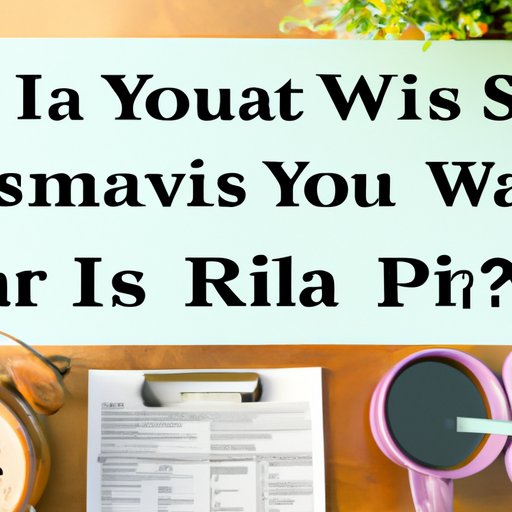Introduction
A Simple IRA (Savings Incentive Match Plan for Employees) is an individual retirement account (IRA) that provides both employer and employee contributions. It’s designed to give small businesses with fewer than 100 employees an option to offer a retirement savings plan without the administrative hassle and cost of more complex plans. The Simple IRA is easy to set up and administer, making it a popular option for small business owners.
Explaining the Basics of Simple IRAs: Who, What, Where, When and How
To understand how a Simple IRA works, you need to know who can participate, what is a Simple IRA, where you can set one up, when you can contribute, and how to establish a Simple IRA.
Who Can Participate in a Simple IRA?
Employers of any size can set up a Simple IRA, although it’s most commonly used by small businesses with fewer than 100 employees. Employees of participating companies are eligible to make contributions to their Simple IRA as long as they earn at least $5,000 in income from the employer during the year.
What is a Simple IRA?
A Simple IRA is a type of traditional IRA that allows employers and employees to contribute to the same account. Both employer and employee contributions are pre-tax, meaning they are not subject to federal or state income taxes until they are withdrawn. The money in a Simple IRA can be invested in stocks, bonds, mutual funds, and other investments.
Where Can I Set Up a Simple IRA?
You can open a Simple IRA at any financial institution that offers traditional IRAs. This includes banks, credit unions, brokerage firms, and online investment platforms. You’ll need to provide basic information about yourself and your employer to open the account.
When Can I Contribute to a Simple IRA?
Employees can start contributing to a Simple IRA at any time. However, employers must wait until the end of the tax year to make contributions. If your employer decides to match employee contributions, those contributions must be made within 3 months of the end of the tax year.
How to Establish a Simple IRA
Setting up a Simple IRA is relatively straightforward. Your employer will need to fill out a form with the IRS and provide it to you so you can open an account. Once the account is established, you (and your employer, if applicable) can begin making contributions.
A Guide to Understanding Your Employer’s Simple IRA Plan
If your employer offers a Simple IRA plan, there are a few key things you’ll need to know before you start investing. Here’s a brief guide to understanding your employer’s Simple IRA plan.
Eligibility for Employer Contributions
Employers can choose to match employee contributions up to a certain percentage. For example, an employer may match 50% of employee contributions up to 6% of the employee’s salary. This means that if an employee contributes 6% of their salary to their Simple IRA, the employer will contribute an additional 3%.
Investment Options
The investment options available in a Simple IRA depend on the financial institution you use to open the account. Most institutions offer a variety of stocks, bonds, mutual funds, and other investments. Be sure to research the fees and performance of each option before you invest.
Contribution Limits
The amount you can contribute to your Simple IRA is limited to $13,500 per year ($16,500 if you’re age 50 or older). This includes both employer and employee contributions. Your employer may also impose additional contribution limits, so be sure to check with them before you make any contributions.
What are the Benefits of a Simple IRA?
A Simple IRA has several benefits that make it attractive to employers and employees alike. Here are some of the top benefits of a Simple IRA.
Tax Advantages
Contributions to a Simple IRA are pre-tax, meaning they are not subject to federal or state income taxes until they are withdrawn. This can result in significant tax savings over time.
Flexibility
Unlike other employer-sponsored retirement plans, a Simple IRA offers flexible contribution amounts. Employees can contribute as much or as little as they like, and employers have the option to match employee contributions up to a certain percentage.
Easy Access to Funds
Because a Simple IRA is an individual retirement account, you can access your funds at any time. However, there may be penalties for early withdrawals, so it’s best to consult with a financial advisor before taking money out of your account.
How to Maximize Your Contributions to a Simple IRA
Making regular contributions to your Simple IRA is the best way to ensure you reach your retirement goals. Here are a few tips for maximizing your contributions.
Making Regular Contributions
Making regular contributions to your Simple IRA is the best way to ensure you reach your retirement goals. Set up automatic transfers from your bank account or paycheck to your Simple IRA to make sure you’re contributing consistently. Even small contributions can add up over time.
Taking Advantage of Catch-up Contributions
If you’re age 50 or older, you can take advantage of catch-up contributions. This allows you to contribute up to an additional $3,000 per year to your Simple IRA. This can be a great way to boost your retirement savings.

Common Questions About Simple IRAs: What to Ask Before You Invest
Before you invest in a Simple IRA, there are a few questions you should ask to make sure it’s the right choice for you. Here are some common questions to consider.
What Fees Are Associated with a Simple IRA?
The fees associated with a Simple IRA vary depending on the financial institution you use. Be sure to research the fees associated with the institution you choose to make sure you’re getting the best deal.
Are There Any Restrictions on Withdrawals?
Yes, there are restrictions on withdrawals from a Simple IRA. Generally, you can’t withdraw funds from your account until you reach age 59 ½. If you do withdraw funds before that age, you may be subject to taxes and penalties.
Are There Any Penalties for Early Withdrawal?
Yes, there are penalties for early withdrawal from a Simple IRA. Generally, you’ll be subject to a 10% penalty plus taxes on the amount withdrawn. It’s best to consult with a financial advisor before making any withdrawals to make sure you understand the potential consequences.
Conclusion
A Simple IRA is a great option for small businesses looking to offer a retirement savings plan to their employees. It’s easy to set up and administer, and offers tax advantages and flexibility. Knowing the basics of how a Simple IRA works and understanding your employer’s Simple IRA plan can help you make informed decisions about your retirement savings.
(Note: Is this article not meeting your expectations? Do you have knowledge or insights to share? Unlock new opportunities and expand your reach by joining our authors team. Click Registration to join us and share your expertise with our readers.)
